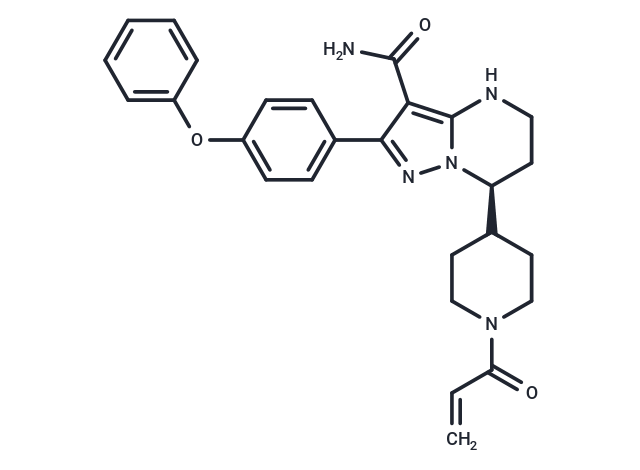Shopping Cart
Remove All Your shopping cart is currently empty
Your shopping cart is currently empty
Zanubrutinib (BGB-3111) is an inhibitor of Bruton tyrosine kinase (BTK).

| Pack Size | Price | USA Warehouse | Global Warehouse | Quantity |
|---|---|---|---|---|
| 1 mg | $57 | In Stock | In Stock | |
| 5 mg | $147 | In Stock | In Stock | |
| 10 mg | $263 | In Stock | In Stock | |
| 25 mg | $546 | In Stock | In Stock | |
| 50 mg | $818 | In Stock | In Stock | |
| 100 mg | $1,130 | In Stock | In Stock | |
| 1 mL x 10 mM (in DMSO) | $153 | In Stock | In Stock |
| Description | Zanubrutinib (BGB-3111) is an inhibitor of Bruton tyrosine kinase (BTK). |
| Targets&IC50 | Rec1 cells:0.36 nM, TMD8 cells:3.8 nM, MOLM-13 cells:5095 nM, BTK:0.3 nM, Ramos cells:1.8 nM, Jurkat cells:3477 nM, HEK293 cells:204.7 nM, OCI-LY1 cells:0.35 nM, Sf9 cells:0.3 nM |
| In vitro | In both biochemical and cellular assays, zanubrutinib demonstrated nanomolar BTK inhibition activity. In several MCL and DLBCL cell lines, zanubrutinib inhibited BCR aggregation-triggered BTK autophosphorylation, blocked downstream PLC-γ2 signaling, and potently inhibited cell proliferation. In comparison with ibrutinib, zanubrutinib showed much more restricted off-target activities against a panel of kinases, including ITK. While ibrutinib significantly inhibited rituximab-induced NK cell IFN-γ secretion and in vitro cytotoxicity on mantle cell lymphoma cells, zanubrutinib was at least 10-fold weaker than ibrutinib in inhibiting rituximab induced ADCC, consistent with its weak ITK inhibition activity[1]. |
| In vivo | In mouse BTK occupancy assays, treatment with zanubrutinib resulted in a dose-dependent BTK occupancy and showed about 3-fold more potency than ibrutinib in target organs, including PBMC and spleen.zanubrutinib induced dose-dependent anti-tumor effects against REC-1 MCL xenografts engrafted either subcutaneously or systemically via tail vein injection in mice.In the subcutaneous xenografts, zanubrutinib at 2.5 mg/kg BID showed similar activity as ibrutinib at 50 mg/kg QD, its clinical relevant dose.In the systemic model, the median survival of zanubrutinib 25 mg/kg BID group was significantly longer than those of both ibrutinib 50 mg/kg QD and BID groups.In an ABC-subtype DLBCL (TMD-8) subcutaneous xenograft model, zanubrutinib also demonstrated better anti-tumor activity than ibrutinib.Preliminary 14-day toxicity study in rats showed that zanubrutinib was very well tolerated and maximal tolerate dose (MTD) was not reached when it was dosed up to 250mg/kg/day[1]. |
| Synonyms | BGB-3111 |
| Molecular Weight | 471.55 |
| Formula | C27H29N5O3 |
| Cas No. | 1691249-45-2 |
| Smiles | NC(=O)c1c2NCC[C@@H](C3CCN(CC3)C(=O)C=C)n2nc1-c1ccc(Oc2ccccc2)cc1 |
| Relative Density. | 1.33 g/cm3 (Predicted) |
| Storage | store at low temperature | Powder: -20°C for 3 years | In solvent: -80°C for 1 year | Shipping with blue ice/Shipping at ambient temperature. | |||||||||||||||||||||||||||||||||||
| Solubility Information | DMSO: 257.5 mg/mL (546.07 mM), Sonication is recommended. | |||||||||||||||||||||||||||||||||||
| In Vivo Formulation | 10% DMSO+40% PEG300+5% Tween 80+45% Saline: 5 mg/mL (10.6 mM), Sonication is recommended. Please add the solvents sequentially, clarifying the solution as much as possible before adding the next one. Dissolve by heating and/or sonication if necessary. Working solution is recommended to be prepared and used immediately. The formulation provided above is for reference purposes only. In vivo formulations may vary and should be modified based on specific experimental conditions. | |||||||||||||||||||||||||||||||||||
Solution Preparation Table | ||||||||||||||||||||||||||||||||||||
DMSO
| ||||||||||||||||||||||||||||||||||||
| Size | Quantity | Unit Price | Amount | Operation |
|---|

Copyright © 2015-2025 TargetMol Chemicals Inc. All Rights Reserved.